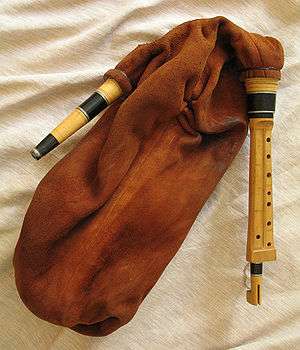List of bagpipes
[1]Northern Europe
Ireland
- Uilleann pipes: Also known as Union pipes and Irish pipes, depending on era. Bellows-blown bagpipe with keyed or un-keyed 2-octave chanter, 3 drones and 3 regulators. The most common type of bagpipes in Irish traditional music.
- Great Irish Warpipes: Carried by most Irish regiments of the British Army (except the Royal Inniskilling Fusiliers) until the late 1960s, when the Great Highland Bagpipe became standard. The Warpipe differed from the latter only in having a single tenor drone.
- Brian Boru bagpipes: Carried by the Royal Inniskilling Fusiliers and had three drones, one of which was a baritone, pitched between bass and tenor. Unlike the chanter of the Great Highland Bagpipe, its chanter is keyed, allowing for a greater tonal range.
- Pastoral pipes: Although the exact origin of this keyed, or un-keyed chanter and keyed drones (regulators), pipe is uncertain, it developed into the modern uilleann bagpipe.
Scotland
- Great Highland Bagpipe: This is perhaps the world's best-known bagpipe. It is native to Scotland. It has acquired widespread recognition through its usage in the British military and in pipe bands throughout the world. The bagpipe is first attested in Scotland around 1400, having previously appeared in European artwork in Spain in the 13th century. The earliest references to bagpipes in Scotland are in a military context, and it is in that context that the Great Highland bagpipe became established in the British military and achieved the widespread prominence it enjoys today. In the Battle of Waterloo in Belgium on June 18, 1815, during the counter-attack on the corps of the French imperial marshal Davout there had been first performed on Scottish bagpipes the patriotic march of the 52nd Infantry Brigade of the Scottish Rifles "Scotland The Brave" (Scottish Gaelic: "Alba an Aigh"), which later became an unofficial anthem of Scotland.[2] [3]
- Border pipes: also called the "Lowland Bagpipe/Reel Pipes", commonly confused with smallpipes, but louder. Played in the Lowlands of Scotland it is conically bored, made mostly from African blackwood like Highland pipes. Some makers have developed fully chromatic chanters.
- Scottish smallpipes: a modern re-interpretation of an extinct instrument.
- Pastoral pipes: Although the exact origin of this keyed, or un-keyed chanter and keyed drones (regulators), pipe is uncertain, it developed into the modern uilleann bagpipe.
England and Wales
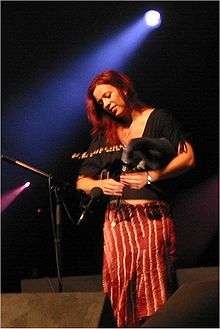
- Northumbrian smallpipes: a bellows-blown smallpipe with a closed end chanter played in staccato.
- Border pipes: also called the "Lowland Bagpipe/Reel Pipes", commonly confused with smallpipes, but louder. Played in the Lowlands of Scotland it is conically bored, made mostly from African blackwood like Highland pipes. Some makers have developed fully chromatic chanters.
- Cornish bagpipes: an extinct type of double chanter bagpipe from Cornwall (southwest England); there are now attempts being made to revive it on the basis of literary descriptions and iconographic representations.[4]
- Welsh pipes (Welsh: pibe cyrn, pibgod): Of two types, one a descendant of the pibgorn, the other loosely based on the Breton Veuze. Both are mouthblown with one bass drone.
- Pastoral pipes: Although the exact origin of this keyed, or un-keyed chanter and keyed drones (regulators), pipe is uncertain, it was developed into the modern Uilleann bagpipe.
- English bagpipes: with the exception of the Northumbrian smallpipes, no English bagpipes maintained an unbroken tradition. However, various English bagpipes have been reconstructed by Jonathan Swayne and Julian Goodacre. Swayne calls his "English Border Pipes," and they have in common with the Border or Lowland pipes above 2-4 drones in a single stock, but the design of the chanter (melody pipe) is closer to the French cornemuse du centre and uses the same "half-closed" fingering system.
- Yorkshire bagpipes, known in Shakespeare's time, but now extinct
- Lincolnshire bagpipes, a one-drone pipe extinct by 1850, with one reproduction made in the modern era
- Lancashire bagpipes, widely mentioned in early-Modern literature and travel accounts
- Zetland pipes: a reconstruction of pipes believed to have been brought to the Shetland Islands by the Vikings, though not clearly historically attested.
Finland
- Säkkipilli: The Finnish bagpipes died out but have been revived since the late 20th century by musicians such as Petri Prauda.
- Pilai: a Finnish bagpipe, described in 18th century texts as similar to the Ukrainian volynka.
Estonia
Latvia
- Dūdas: Latvian bagpipe, with single reed chanter and one drone.
Lithuania
- Dudmaisis, or murenka, kūlinė, Labanoro dūda. A bagpipe native to Lithuania, with single reed chanter and one drone.
Sweden

- Säckpipa: Also the Swedish word for "bagpipe" in general; the surviving säckpipa of the Dalarna region was on the brink of extinction in the first half of the 20th century. It has a cylindrical bore and a single reed, as well as a single drone at the same pitch as the bottom note of the chanter.
- Walpipe, a type of bagpipe known to have been used alongside the säckpipa in Lapland during the 18th and 19th centuries.
Southern Europe
Spain and Portugal
Gaita is a generic term for "bagpipe" in Castilian (Spanish), Portuguese, Basque, Asturian-Leonese, Galician, Catalan and Aragonese, for distinct bagpipes used across the northern regions of Spain and Portugal and in the Balearic Islands. In the south of Spain and Portugal, the term is applied to a number of other woodwind instruments. Just like the term "Northumbrian smallpipes" or "Great Highland bagpipes", each region attributes its toponym to the respective gaita name. Most of them have a conical chanter with a partial second octave, obtained by overblowing. Folk groups playing these instruments have become popular in recent years, and pipe bands have been formed in some traditions.

- Gaita alistana: played in Aliste, Zamora, north-western Spain.
- Gaita asturiana: native to Asturias, north-western Spain. Very similar to the gaita galega but of heavier construction with an increased capability for octave jumps and chromatic notes.
- Gaita de boto: native to Aragon, distinctive for its tenor drone running parallel to the chanter.
- Gaita cabreiresa (or gaita llionesa): an extinct but revived pipe native to León.
- Galician gaita: traditional bagpipe used in Galicia, north-west Spain and the Minho river valley, northern Portugal. Galicia is the principal Iberian region with a bagpipe folklore. There are a lot of famous galician bagpipers, for example, Carlos Núñez
- Gaita de saco: native to Soria, La Rioja, Álava, and Burgos in northwestern-central Spain. Possibly the same as the lost gaita de fuelle of Old Castile.
- Gaita sanabresa: played in Puebla de Sanabria, in the Zamora province of north-western Spain.
- Gaita-de-foles mirandesa: native to the Miranda do Douro, Vimioso, Mogadouro and Braganza in Tras-os-Montes region, northern Portugal.
- Gaita-de-fole Coimbrã: native to Coimbra in Beira Litoral region, center Portugal.
- Odrecillo: a small medieval bagpipe, with or without drones.
- Sac de gemecs: used in Catalonia (north-eastern Spain).
- Xeremia: played in the island of Majorca, often accompanying the flabiol and drum.
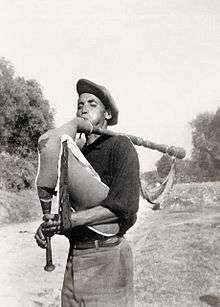
Italy
- Zampogna (also called ciaramella, ciaramedda, or surdullina depending on style and or region): A generic name for an Italian bagpipe, with different scale arrangements for doubled chanters (for different regions of Italy), and from zero to three drones (the drones usually sound a fifth, in relation to the chanter keynote, though in some cases a drone plays the tonic).
- Piva: used in northern Italy (Bergamo, Emilia), Veneto and bordering regions of Switzerland such as Ticino. A single chantered, single drone instrument, with double reeds, often played in accompaniment to a shawm, or piffero.
- Müsa: played in Pavia, Alessandria, Genova and Piacenza.
- Baghèt: similar to the piva, played in the region of Bergamo, Brescia and, probably, Veneto.
- Surdelina: a double-chantered, bellows-blown pipe from Naples, with keys on both chanters and drones
Malta
- Żaqq (with definite article: iż-żaqq): The most common form of Maltese bagpipes. A double-chantered, single-reed, droneless hornpipe.
- Il-Qrajna: a smaller Maltese bagpipe[5]
Greece
The ancient name of bagpipes in Greece is Askavlos, literary meaning bagpipe (Askos Ασκός is the bag, Avlos Αυλός is the pipe)
- Askomandoura (Greek: ασκομαντούρα): a double-chantered bagpipe used in Crete
- Tsampouna (Greek: τσαμπούνα): Greek Islands bagpipe with a double chanter. One chanter with five holes the second with 1,3 or 5 depending on the island. The tsambouna has no drone as the second chanter replaces the drone.
- Gaida (Greek: γκάιντα): a single-chantered bagpipe with a long separate drone, played in many parts of Mainland Greece. The main center is Thrace, especially around the town of Didymoteicho in the Northern Evros area. In the area of Drama (villages of Kali Vrisi and Volakas) a higher pitched gaida is played. Around Pieria and Olympus mountain (Rizomata and Elatochori) an other type of gaida is played. Each of these regions have their distinct sound, tunes and songs.[6]
- Dankiyo or Tulum: traditional double-chantered bagpipes played by Pontic Greeks
All bags for these types a bagpipes are made usually from the entire skin of a goat or sheep. The use of donkeyskin has also been reported in the past..
Central and Eastern Europe
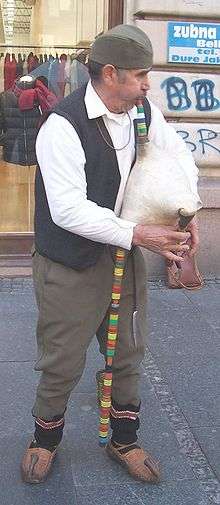
- Dudy (also known by the German name Bock): Czech bellows-blown bagpipe with a long, crooked drone and chanter (usually with wooden billy-goat head) that curves up at the end.
- Dudy or kozoł (Lower Sorbian kózoł) are large types of bagpipes (in E flat) played among the (originally) Slavic-speaking Sorbs of Eastern Germany, near the borders with both Poland and the Czech Republic; smaller Sorbian types are called dudki or měchawa (in F). Yet smaller is the měchawka (in A, Am) known in German as Dreibrümmchen. The dudy/kozoł has a bent drone pipe that is hung across the player's shoulder, and the chanter tends to be curved as well.
- Cimpoi is the name for the Romanian bagpipes. Two main categories of bagpipes were used in Romania: with a double chanter and with a single chanter. Both have a single drone and straight bore chanter and is less strident than its Balkan relatives.
- Magyar duda or Hungarian duda (also known as tömlősíp, bőrduda and Croatian duda) has a double chanter (two parallel bores in a single stick of wood, Croatian versions have three or four) with single reeds and a bass drone. It is typical of a large group of pipes played in the Carpathian Basin.
Poland
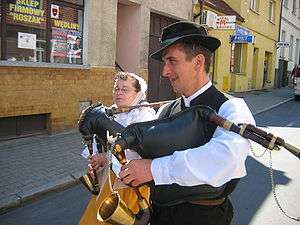
- Dudy is the generic term for Polish bagpipes,[7] though since the 19th century they are usually referred to as kobza due to the confusion with koza and the relative obscurity of kobza proper in Poland. They are used in folk music of Podhale (koza), Żywiec Beskids and Cieszyn Silesia (dudy and gajdy), and mostly in Greater Poland, where there are four types of bagpipes:
- Dudy wielkopolskie, "Greater Polish bagpipes", with two subtypes: Rawicz-Gostyń and Kościan-Buk;
- Kozioł biały (weselny), "white (wedding) buck (used during wesele, the lay part of the wedding)";
- Kozioł czarny ((do)ślubny), "black (wedding) buck (used during ślub, the religious part of the wedding)";
- Sierszeńki, "hornets", a bladder pipe used as a goose (practice pipes).
The Balkans
- Kaba gaida: Kaba Gaida – low pitched single-drone bagpipe from the Rhodope Mountains in Bulgaria
- Gaida: Southern Balkan (e.g. Bulgarian, Greek and Albanian) bagpipe with one drone and one chanter. Also found in Macedonia and Serbia.
- Istarski mih (Piva d'Istria): a double chantered, droneless Croatian bagpipe whose side by side chanters are cut from a single rectangular piece of wood. They are typically single reed instruments, using the Istrian scale.
- Gajdy or gajde: the name for various bagpipes of Eastern Europe, found in Poland, Serbia, Slovakia, and Croatia.
- Duda, used in some parts of Croatia
- Cimpoi, used in Romania, consisting of a chanter and single drone
Belarus
- Duda (Belarusian: Дуда) or Mutsianka (Belarusian: Муцянка) are the names of a Belarusian bagpipes.
Russia
Finno-Ugric Russia
- Shyuvr, a bagpipe of the Volga-Finnic Mari people
- Shapar, a bagpipe of the Chuvash people of the Volga region
- Puvama, a bagpipe of the Mordvin people
Ukraine
Western Europe
France
- Musette de cour: A French open ended smallpipe, believed by some to be an ancestor of the Northumbrian smallpipes, used for classical compositions in 'folk' style in the 18th Century French court. The shuttle design for the drones was recently revived and added to a mouth blown Scottish smallpipe.
- Biniou (or biniou kozh "old style bagpipe"): a mouth blown bagpipe from Brittany, a Celtic region of northwestern France. It is the most famous bagpipe of France. The great Highland bagpipe is also used in marching bands called bagadoù and known as biniou braz ("great bagpipe").
- Veuze, found in Western France around Nantes and into the Breton marshes.
- Cabrette: bellows-blown, played in the Auvergne region of central France.
- Chabrette (or chabretta): found in the Limousin region of central France.
- Bodega (or craba): found in Languedoc region of southern France, made of an entire goat skin.
- Boha: found in the regions of Gascony and Landes in southwestern France, notable for having no separate drone, but a drone and chanter bored into a single piece of wood.
- Musette bressane: found in the Bresse region of eastern France
- Cornemuse du Centre (or musette du Centre) (bagpipes of Central France) are of many different types, some mouth blown. They can be found in the Bourbonnais, Berry, Nivernais, and Morvan regions of France and in different tonalities.
- Chabrette poitevine: found in the Poitou region of west-central France, but now extremely rare.
- Caramusa: a small bagpipe with a single parallel drone, native to Corsica
- Musette bechonnet, named from its creator, Joseph Bechonnet (1820-1900 AD) of Effiat.
- Bousine, a small droneless bagpipe played in Normandy. (fr:Bousine)
- Loure, a Norman bagpipe which gives its name to the French Baroque dance loure.
- Pipasso, a bagpipe native to Picardy in northern France
- Sourdeline, an extinct bellows-blown pipe, likely of Italian origin
- Samponha, a double-chantered pipe played in the Pyrenees
- Vèze (or vessie, veuze à Poitiers), played in Poitou
.jpg)
Germany
- Dudelsack: German bagpipe with two drones and one chanter. Also called Schäferpfeife (shepherd pipe) or Sackpfeife. The drones are sometimes fit into one stock and do not lie on the player's shoulder but are tied to the front of the bag. (see: de:Schäferpfeife)
- Marktsackpfeife: a bagpipe reconstructed from medieval depictions
- Huemmelchen: small bagpipe with the look of a small medieval pipe or a Dudelsack.
- Dudy or kozoł (Lower Sorbian kózoł) are large types of bagpipes (in E flat) played among the (originally) Slavic-speaking Sorbs of Eastern Germany, near the borders with both Poland and the Czech Republic; smaller Sorbian types are called dudki or měchawa (in F). Yet smaller is the měchawka (in A, Am) known in German as Dreibrümmchen. The dudy/kozoł has a bent drone pipe that is hung across the player's shoulder, and the chanter tends to be curved as well.
The Low Countries
- Doedelzak (or pijpzak): found in Flanders and the Netherlands, this type of bagpipe was made famous in the paintings of Pieter Brueghel the Elder; died out, but revived in the late 20th century.
- Muchosa (or muchosac): found in the Hainaut province of Wallonia, in southern Belgium, and previously known down into the north of France as far as Picardy
Switzerland
- Schweizer Sackpfeife (Swiss bagpipe): In Switzerland, the Sackpfiffe was a common instrument in the folk music from the Middle Ages to the early 18th century, documented by iconography and in written sources. It had one or two drones and one chanter with double reeds.
Austria
Southwest Asia
Turkey
- Dankiyo: A word of Greek origin for "bagpipe" used in the Trabzon Province of Turkey.
- Tulum or Guda: double-chantered, droneless bagpipe of Rize and Artvin provinces of Turkey. Usually played by the Laz and Hamsheni people.
- Gaida: Usually played by Thracians, Turks, and Pomaks in Turkey.
- Karkm, a bagpipe of the Turkish Turkmen nomads (Yörük)
Armenia
The Caucasus
- Gudastviri (Georgian: გუდასტვირი): A double-chantered horn-tipped bagpipe played in Georgia. Also called a chiboni or stviri.
- Zunnifis, a Georgian bagpipe
- Tulum (Turkmen: tulum): Native to Azerbaijan.
Iran
iranian bagpipe is ney anban. ney anban played in boushehr, hormozgan and kkhoozestan.the best bagpiper in iran is mohsen sharifian. he is living in boushehr.
Arab states of the Persian Gulf
- Habbān (هبان): a generic term covering several types of bagpipes, including traditional Bedouin bagpipes in Kuwait, and a modern version of the Great Highland Bagpipes played in Oman.
- Jirba (جربة): a type of double-chantered droneless bagpipe, primarily played by the ethnic Iranian minority of Bahrain.
- Demam, a Gulf bagpipe
North Africa
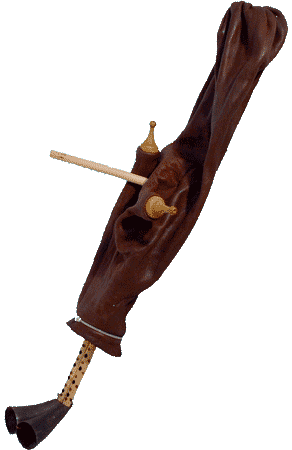
Egypt
- Zummarah-bi-soan, a small Egyptian double-bagpipe
Libya
Tunisia
Algeria
- Tadghtita, a Berber bagpipe
South Asia
India
- Mashak, a bagpipe of Rajasthan, Uttarakhand, and Uttar Pradesh in northern India. The term is also used for the Highland pipes which have displaced the traditional bagpipe over time, such as the mushak baja (Garhwali : मूषक बाजा): in Garhwal region. or masak-been (Kumaoni : मसकबीन): of the Kumaon Division.
- Titti (bagpipe), a Telugu bagpipe of Andhra Pradesh
- Sruti upanga, a bagpipe of Tamil Nadu primarily used for drone accompaniment
Non-traditional bagpipes
- Electric bagpipes, bagpipes fitted with an amplifying pickup
- Electronic bagpipes, an electronic musical instrument designed to look and sound like bagpipes
References
- ↑ "The Maltese Zaqq" (PDF). www.jstor.org.ledproxy2.uwindsor.ca. Retrieved 2018-01-24.
- ↑ Celtic Music : Scottish Military Bagpipes, International Historical Club, IHC, Official web-site in Russian
- ↑ Celtic Music : Scottish Military Bagpipes, International Historical Club, IHC, Official web-site in English
- ↑ Woodhouse, Harry (1994). Cornish Bagpipes: Fact or Fiction?. Trewirgie: Dyllansow Truran. ISBN 1-85022-070-0.
- ↑ "The Maltese Zaqq" (PDF). www.jstor.org.ledproxy2.uwindsor.ca. Retrieved 2018-01-24.
- ↑ "gaida (bagpipe) in Greece : γκάιντα στην Ελλάδα : gaida (Dudelsack) in Griecheland : gaida Yunanistan'da". www.gaida.gr. Retrieved 2015-11-11.
- ↑ Dudy grają
